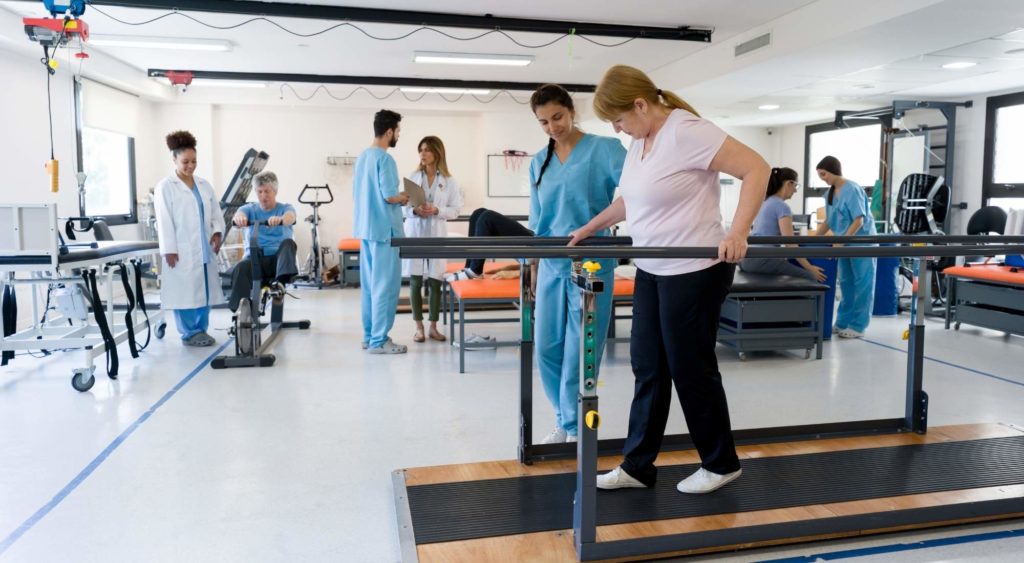
Your physician recently recommended you visit a physical therapist because of the current ailment you’re facing, but you’ve heard that occupational therapy may be helpful, too.
You’ve been researching online and just can’t figure out how to choose between occupational therapy and physical therapy.
In this guide, we’re providing all the information you need to compare occupational therapy vs. physical therapy so you can understand the differences and choose the best route to take.
Table of Contents
- Occupational vs. Physical Therapy: Is There A difference?
- How Is Occupational Therapy Different From Physical Therapy?
- Do Physical Therapy and Occupational Therapy Treatments Overlap?
- Where Does Occupational vs. Physical Therapy Take Place?
- How Do I Know If I Need Occupational vs. Physical Therapy?
- When is Physical Therapy vs. Occupational Therapy Needed?
Occupational vs. Physical Therapy: Is There a Difference?
Physical therapy and occupational therapy have very similar goals.
Both have the same overall purpose of improving a patient’s overall function, well-being, and quality of life. Both physical and occupational therapy are very hands-on and tailored specifically to each patient’s needs.
No matter which therapy a patient is in — occupational therapy vs. physical therapy — the therapist will be setting goals and monitoring a patient’s progress throughout their treatment.
But what are the differences between occupational vs physical therapy?
- Physical therapy’s main goals focus on gross motor function.
- Occupational therapy’s main goals focus on cognitive and fine motor skills needed to perform everyday tasks.
Physical Therapist
Physical therapists are physical movement professionals.
They are experts of human anatomy and all of the different bodily systems. Typically, physical therapists help treat…
- Injuries
- Problems; or
- Limitations
….a patient has.
Physical therapists work to help patients restore function, alleviate pain, and improve mobility by promoting healthy physical fitness.
Physical therapists assess how a patient’s body’s mobility and stability play a role in their pain or ailments. They can:
- Identify how lack of mobility in a part of the body is causing pain
- Provide a treatment plan
- Reduce pain through exercise
- Help patients avoid (re)injuring a body part; or
- Rehabilitate a body part after surgery or injury.
Physical therapists go through years of schooling to ensure they are providing patients with the best and most reliable care.
They must also be licensed in the state that they practice in.
Examples of Physical Therapy Specialties
Physical therapists work in many different specialties, such as:
- Pediatric physical therapy — physical therapists can work with children as young as a few weeks old to the age of 18 to overcome any pre-existing conditions, injuries, or illnesses and diseases that affect their mobility.
- Orthopedic physical therapy — this type of physical therapy focuses on diagnosing and treating different parts of the musculoskeletal system.
- Cardiovascular rehabilitation — often used to help recover from heart attacks, this type of physical therapy involves exercise training like riding a stationary bike.
- Geriatric physical therapy — one of the most common reasons seniors need physical therapy is when they are recovering from a fall. Physical therapists help seniors strengthen their muscles and teach techniques to prevent falls from happening again in the future.
The physical therapists at In Motion O.C. have a strong desire to serve others. If you’re concerned that you may need physical therapy, one of our therapists can assess your concerns during a free consultation.
Examples of Physical Therapy Services
What happens during physical therapy?
Here are some examples of what you might do while at a physical therapy appointment:
- Stretching
- Rehabilitation exercises to help you learn how to use an artificial limb
- Learn how to use gadgets that help with mobility and balance — walkers, canes, wheelchairs, etc.
- Massage therapy
- Ultrasound therapy
- Heat or cold therapy

Occupational Therapist
On the other hand, occupational therapists treat patients who need assistance with day-to-day activities.
They help patients develop, improve and maintain the skills needed for everyday living.
Occupational therapists assist with…
- Physical
- Sensory
- Cognitive
…problems or injuries.
Occupational therapy is a way of learning how to adapt and perform tasks that promote functional independence.
Therapists also must be licensed in the state that they work in and are required to have a minimum of a Bachelor’s degree in a related field such as exercise science or health sciences, followed by a master’s degree in occupational therapy.
Examples of Occupational Therapy Specialties
Occupational therapists generally help patients overcome obstacles they face while doing activities of daily living.
This may involve building hand strength after a stroke, or improving hand-eye coordination.
Specialties include:
- Gerontology — an occupational therapist specializing in gerontology helps elderly patients learn other techniques to accomplish activities of daily living, such as bathing, eating, or dressing — with limited mobility from a body part.
- Pediatrics — pediatric occupational therapists specialize in helping children successfully accomplish everyday activities that involve learning, socializing, and playing.
Examples of Occupational Therapy Services
An occupational therapist might assist you with the following activities:
- Activities of daily living — bathing, dressing, driving, grooming, etc.
- Compensating for memory loss or vision impairment — an occupational therapist can help patients adapt to their surroundings and create a safe environment in their homes.
- Improve fine motor skills — like helping a child learn how to grasp a pencil and improve hand strength.
- Learn how to use adaptive equipment — stroke sufferers, for example, may need to use silverware during mealtimes that have a bigger grip.
How Is Occupational Therapy Different From Physical Therapy?
Let’s take a closer look at occupational therapy vs. physical therapy to narrow in on the differences.
Occupational therapists help patients complete everyday tasks they:
- Need to do
- Want to do; or
- Are expected to do.
Let’s take Bob, for example, who recently had a stroke.
An occupational therapist will look at how he is able to function daily based on damage caused by the stroke to the various parts of his brain. Bob’s occupational therapist will likely look at if Bob can cook and clean for himself at home.
If not, his occupational therapist can provide…
- Coaching
- Adaptive equipment; and
- Mental exercises
…to help him get back to doing these daily activities to the best of his ability.
Now, let’s look at how physical therapy differs from occupational therapy.
Physical therapy typically treats a specific physical impairment.
While the physical impairment could also be because of a stroke (we’ll touch on this overlap in the next section) it’s important to note the biggest difference between the two therapies.
To do this, let’s look at Angie as an example.
Angela was recently in a car accident and experienced whiplash. It’s been two weeks, and her neck pain has not subsided, so her physician recommended she start physical therapy.
After her initial assessment, Angela’s physical therapist shows her different therapeutic stretches and strengthening exercises to reduce the pain she’s experiencing and gain movement back in her neck.

Do Physical Therapy and Occupational Therapy Treatments Overlap?
Yes, there are many circumstances where physical therapy and occupational therapy work hand in hand.
Let’s look at Gerry’s situation to see how the two overlap.
Gerry is recovering from a hip replacement and her physician gave her a referral for occupational therapy and physical therapy.
Gerry’s physical therapist helps Gerry improve her ambulation, her lower-body strength, and balance.
Her occupational therapist, on the other hand, will work with Gerry to help her with:
- Getting dressed with very little movement
- Providing supportive equipment to be used during recovery; and
- Teach her ways to adapt when dressing, bathing, or going to the bathroom while recovering from surgery.
Gerry’s occupational therapist and physical therapist work together to create a care plan that helps Gerry heal and get back to doing the things she loves with minimal assistance.
Where Does Occupational vs. Physical Therapy Take Place?
Physical therapy and occupational therapy can take place in many settings. In some instances, they can take place in the same setting.
Physical therapists and occupational therapists work in settings like:
- Home health agencies
- Schools
- Fitness centers/gyms
- Hospitals
- Nursing Homes
- Outpatient clinics
- Offices specifically for physical therapy
Unlike occupational therapists, physical therapists may also be found in gyms and fitness centers.
How Do I Know If I Need Occupational vs. Physical Therapy?
Which therapy is right for you will depend on your condition and your unique needs.
If an injury or condition affects your ability to move a body part without pain, physical therapy might be the right route for you.
Suppose you’ve had a hard time performing everyday activities like being able to write with a pen or dress yourself. In this case, an occupational therapist can help improve your motor skills needed to perform these tasks.
In the following sections, we’re providing examples of when you might need physical therapy vs. occupational therapy.
When is Physical Therapy vs. Occupational Therapy Needed?
Distinguishing when you might need occupational vs. physical therapy can be difficult. To make it easier, we’ve provided a brief overview of what each treatment can assist patients with.
Physical therapy helps with:
- Improving mobility after an injury
- Rehabilitation after surgery
- Improving endurance
- Gross motor skills
- Managing pain
- Rehabilitation after a stroke
- Conditions like carpal tunnel, osteoarthritis, and rheumatoid arthritis
- Urinary incontinence
- Etc.
Occupational therapy helps patients develop:
- Fine motor skills
- Visual skills
- Cognitive skills
- Sensory-processing problems
- Etc.
Always talk with your doctor about figuring out which type of therapy is right for you.

Looking For a Physical Therapist? In Motion O.C. Is Rated The #1 Clinic In The Nation On Yelp!
In Motion O.C.’s hand-picked physical therapists offer first-class experiences from the second you walk in our door.
Our therapists are the experts in the field and are trained on the most up-to-date techniques and equipment to help you overcome the physical obstacles you’re facing and live a pain free life.
We use state-of-the-art tools and technology in a setting that is both peaceful and professional.
We aim to deliver physical therapy services as efficiently and effectively as possible. Our mission is to give hope, healing, confidence, and joy to others.
Some of our specialty programs include:
- Women’s health
- Neck health
- Back health
- Fall prevention
- HIp rehabilitation
- Aquatic therapy
- And more
Are you curious whether occupational vs. physical therapy is right for you? Contact us today to schedule a free consultation with one of our licensed physical therapists at no cost to you.
During your consultation, we can determine if your ailments are something we can treat through physical therapy and recommend a treatment plan that fits your needs.



